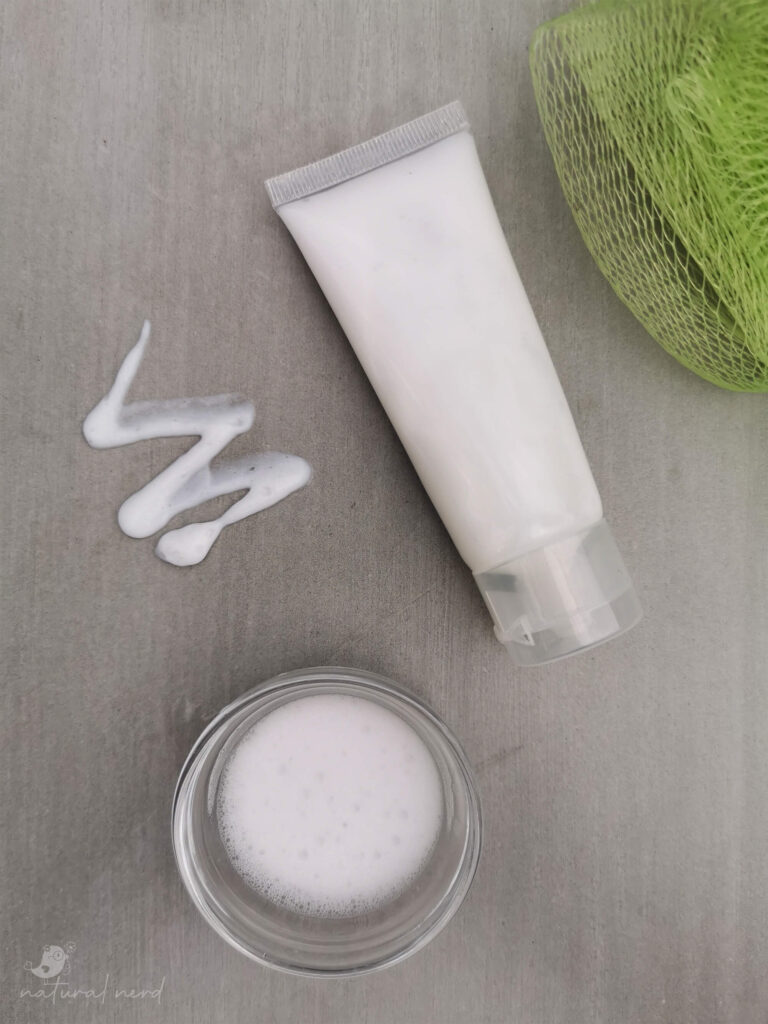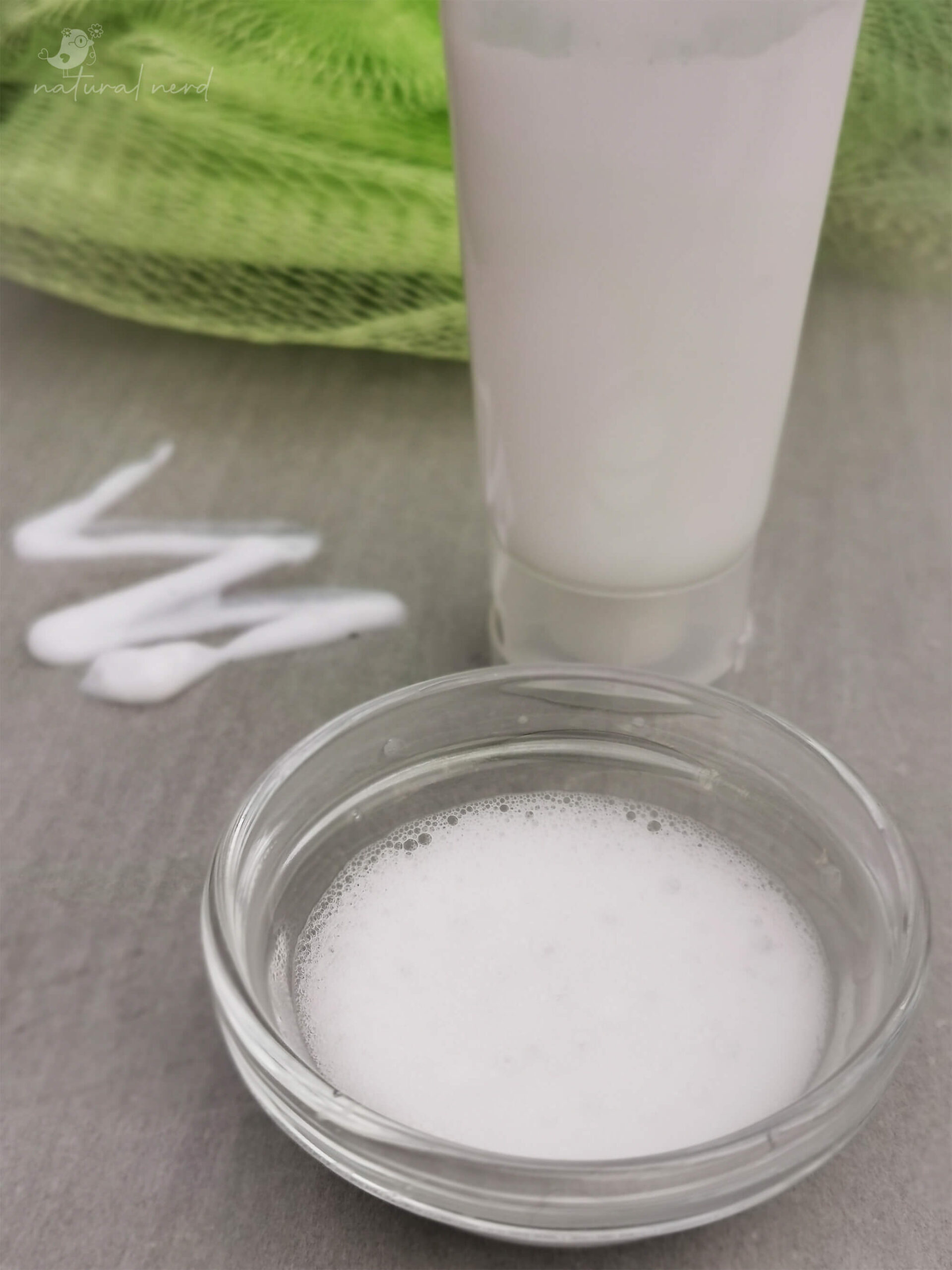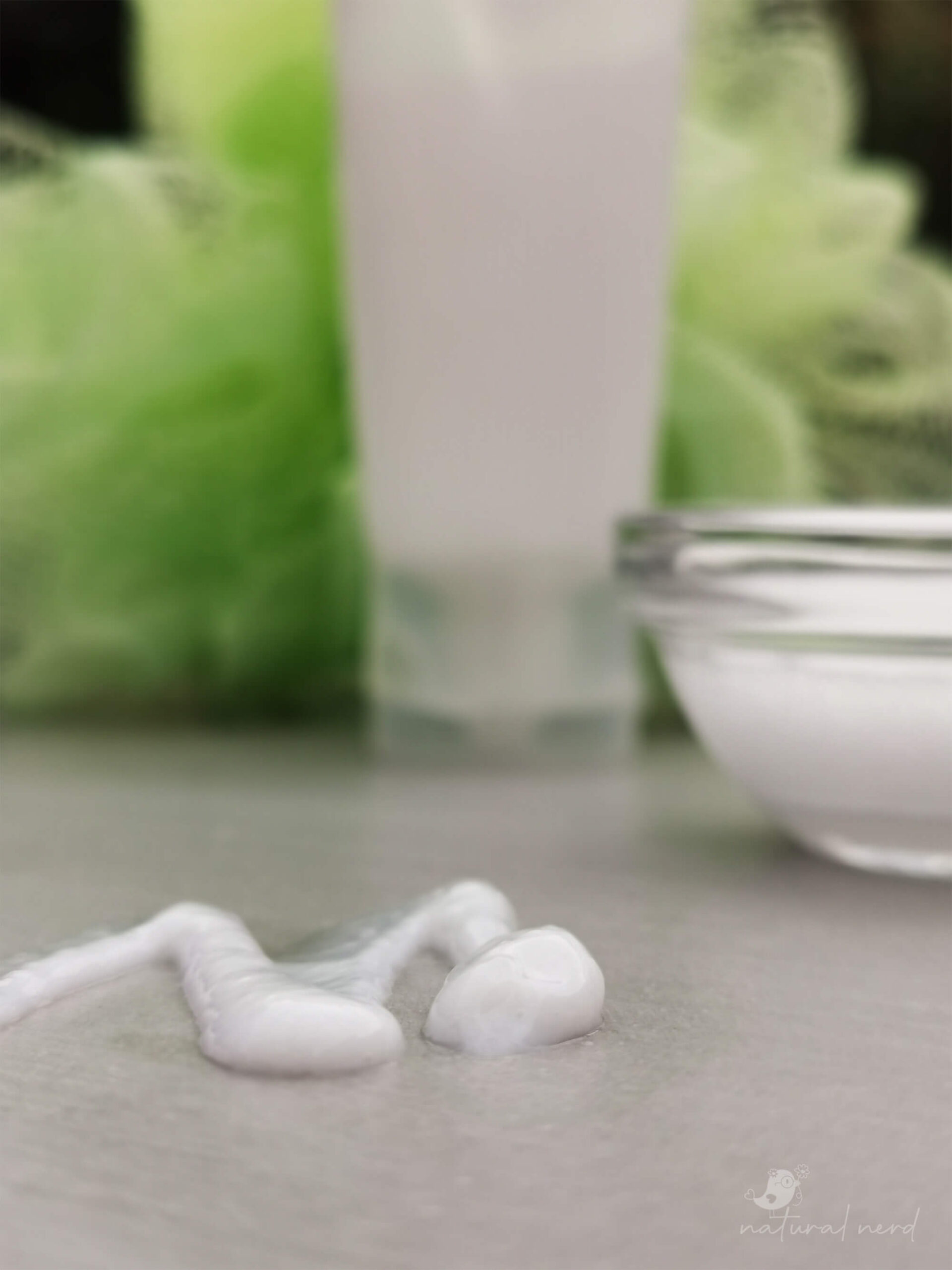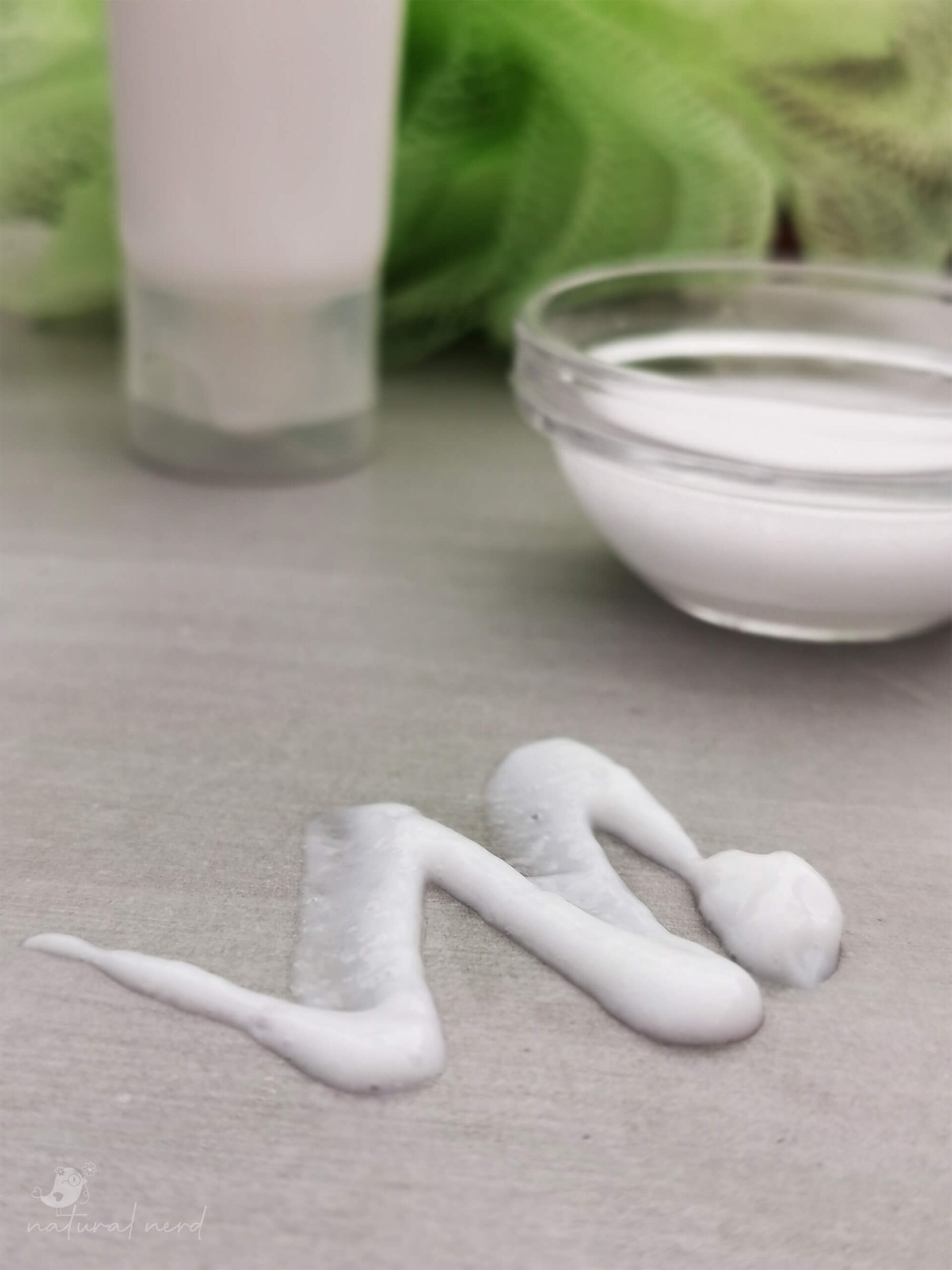
If you simply want clean hair and nothing else, then this is your go-to shampoo recipe without frills or fragrance. Beginner DIYers will love this recipe for it’s short and affordable ingredient list. This shampoo is a step-up from washing your hair with natural soap, because it’s pH-balanced. It contains mild, natural surfactants and zero fragrance, therefore this is also an ideal shampoo for sensitive skin and babies.
Minimalist Vegan Shampoo
Ingredients
- 152g Deionised / Distilled Water (plus extra for step 8)
- 20g Sodium Cocoyl Isethionate (SCI)
- 16g Decyl Glucoside
- 10g Vegetable Glycerine
- 2g Geogard Ultra (preservative)
- 0.5g Xanthan Gum
Instructions
- Makes 200g.
- First measure the weight of the stainless steel pot or glass beaker that you will be making the shampoo in. Write down this weight. Also write down what the weight should be once you add the weight of the final shampoo (200g). For example, my pot weighs 202g, and with the final shampoo it should weigh 402g (Calculation: 202g pot + 200g product = 402g).
- In this pot/beaker, bring the distilled water to a boil.
- While you are waiting for the water to start boiling, combine the glycerine, xanthan gum and Geogard Ultra powder into a paste. Set aside.
- As soon as the water starts boiling, add the SCI flakes/powder to the boiling water until it has dissolved completely.
- When the SCI is dissolved, remove the pot/beaker from the heat.
- Stir in the remaining ingredients: Decyl glucoside and the glycerine paste from step 4.
- Now weigh your pot/beaker again and top-up with distilled water until the final product weight is achieved (which you wrote down in step 2). Eg. My pot weighed 386g here, so I added 16g distilled water in order to achieve the final weight of 402g. You are replacing the water content that evaporated.
- Stir in the replaced water, and then cover and let your shampoo stand. It will thicken and turn opaque white as it cools down. You should see the final shampoo texture in about 3 hours when it has completely cooled down.
- After at least 3 hours, you can test and correct the pH if necessary to be between pH 4.5-5.5.
- Transfer your shampoo into a sterilised bottle and use within 3 months. This shampoo will work in a pump bottle or squeeze tube.
Notes
- Be very careful not to inhale SCI! Even when you’re measuring SCI flakes, particles always become airborne. Always wear a well-fitted mask. I even hold my breath while measuring SCI, and then step outside to breathe while SCI settles down again.
- You can multiply or divide the quantities to make a larger or smaller batch. If this is your first attempt, then I recommend halving the recipe quantities and testing the shampoo on your hair type first.
- When I make this recipe, the shampoo tests at pH 4.6 which is perfect for hair. Therefore, I don’t have to correct the pH of this shampoo.
- You should do your own pH testing to be sure that your product is pH balanced. Always test at room temperature with a digital pH meter or pH strips. To correct upwards add a couple of drops of a 25% sodium bicarbonate or sodium hydroxide solution. To correct downwards add a few drops of a 50% citric acid solution. Stir in thoroughly and re-test. Repeat until the desired pH is achieved.
- For babies, make an extra effort to balance the pH to exactly pH 5.5.

Recipe Variations & Substitutions
Surfactants:
I really don’t recommend substituting the surfactants in this recipe. Nevertheless, if you must substitute then the best 1:1 replacement for SCI will be Sodium Lauryl Sulfoacetate (SLSa). However, using SLSa means that the shampoo won’t be palm-free. For the decyl glucoside, the best 1:1 substitute is coco glucoside (also a palm-free version preferably). I wouldn’t use lauryl glucoside in this recipe, because the shampoo will be way too thick.
Trust me when I say that I have tried many different natural surfactant blends, and this is the best. It’s taken three months of development and dozens of sample formulations to get here. Of course, you can go down the same road and use any blend of surfactants to find what works for you.
Deionised water:
If you would like some fragrance or plant-powered properties, then you can replace the water with a botanical hydrosol or floral water instead (like rose water). As always, you can also use distilled water instead of deionised water.
Xanthan gum:
You can use another thickener, like guar gum or carrageenan, instead of xanthan gum. Just bear in mind that each thickener has different properties in terms of what it will bring to the product texture, clarity and scent. If you want to add some conditioning properties to your shampoo, you could use a cationic gum, but then it will no longer be a clarifying shampoo, because cationic gums will coat the hair in order to condition it.
Geogard Ultra (Preservative):
You can use any water-soluble, broad spectrum preservative which is compatible in an acidic pH range. Just remember to adjust my recipe according to the manufacturer’s instructions and usage rates, and to test and correct the pH accordingly. Another reason that I use Geogard Ultra in shampoo is because it drifts the pH downwards, which is what I want with most surfactant products. It means that I often don’t have to correct the pH with citric acid – so less effort.

Cost & Shelf Life
Cost price: R34 per 200g. (Costs accurate at time of writing in 2023)
Lasted me about: 1 month in a household of two people, with each of us using about a tablespoon of shampoo twice per week.
Estimated shelf life: 3 months if stored in a sterilised container, and out of direct sunlight.
Challenge
- Contains no ingredients that nourish the hair: It’s just a mild cleanser for the hair (and skin). If you want extra goodies like proteins and conditioning actives, please refer to my Mint & Rosemary Shampoo (for intermediate DIYers) or my High-Performance Herbal Shampoo for more advanced formulators.
- Subtle detergent scent is noticeable from the surfactants, since there is no added fragrance. It smells a bit like Sanex Zero shower gel. If this bothers you, then substitute the plain distilled water for a fragrant hydrosol, or add up to 10 drops of essential oils to the final shampoo.
Cherry on Top
- Vegan Friendly
- Eczema friendly, but I can only speak for myself.
- Sulfate Free
- Curly Girl approved ingredients
- Multipurpose: This doubles-up as a pH balanced body/face/hand wash. It’s the perfect multipurpose cleanser for the minimalist lifestyle.
- Clarifying: You can use this as a clarifying shampoo before you dye your hair to remove product build-up.
- Customisable Base: You can use this as a base shampoo to add your own essential oil blend (max 0.5% / 10 drops).
- Palm Free: The ingredients I chose are typically derived from coconut sources (but please do check with your supplier).
- Contains no cocamidopropyl betaine: which is a common ingredient that many people have an allergy / irritation to (including myself).

Ingredients
- Deionised / Distilled Water: is a pure, pharmaceutical grade of water that is suitable for cosmetics. It contains no minerals or ions. It is not the same as bottled, filtered or spring water and cannot be substituted by these. You can find distilled water at most pharmacies. (buy here).
- Sodium Cocoyl Isethionate: or SCI is a mild, natural surfactant derived from coconuts. It is the primary cleanser in this recipe which provides dense and stable foam without stripping the hair. It is also responsible for the snow white colour of the shampoo. (buy here)
- Decyl glucoside: is a natural surfactant that is derived from plant sources. Depending on the supplier, it can be derived from corn, coconut or palm oil. This non-ionic surfactant supports the SCI in the recipe and boosts lather (buy here).
- Vegetable glycerine: is a natural humectant that will help the hair retain some moisture, thereby making it more manageable after being cleansed. It is also necessary to hydrate the xanthan gum. (buy here)
- Xanthan gum: stabilises the texture of the product by gelling the available water in the shampoo (buy here).
- Geogard Ultra: is a broad-spectrum preservative which is approved for use in certified organic products. It is approved by COSMOS/ECOCERT, NATRUE and SOIL association. It is composed of sodium benzoate and gluconolactone. (buy here)
Safety Precaution
Please be very careful not to inhale SCI or any other solid surfactant! Even when you’re measuring SCI flakes, tiny particles always become airborne that will irritate your lungs. Always wear a well-fitted mask. I even hold my breath while measuring SCI, and then step outside to breathe while the SCI settles down again. Leave your mask on until the SCI has been melted down into a liquid/ paste form.
Not sure where to find these, or other ingredients? My shopping guide may help you. Are you new to essential oils? Please read how to use them safely.
How has this minimalist shampoo recipe worked for you? Please share in the comments section below.
